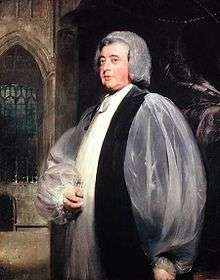John Moore (archbishop of Canterbury)
| The Most Reverend and Right Honourable John Moore | |
|---|---|
| Archbishop of Canterbury | |
 | |
| Church | Church of England |
| Province | Canterbury |
| Diocese | Canterbury |
| Elected | 26 April 1783 (confirmation of election)[1] |
| Term ended | 18 January 1805 (death) |
| Predecessor | Frederick Cornwallis |
| Successor | Charles Manners-Sutton |
| Other posts |
Dean of Canterbury (1771–1775) Bishop of Bangor (1774–1783) |
| Personal details | |
| Born |
26 April 1730 Gloucester, Gloucestershire, England |
| Died |
18 January 1805 (aged 74) Lambeth, Surrey, England |
| Buried | St Mary-at-Lambeth |
| Denomination | Anglican |
| Alma mater | Pembroke College, Oxford |
Ordination history of John Moore | |||||||||||||
|---|---|---|---|---|---|---|---|---|---|---|---|---|---|
| |||||||||||||
|
| |||||||||||||
| Source(s): [2] | |||||||||||||
John Moore (26 April 1730 – 18 January 1805) was Archbishop of Canterbury in the Church of England.
Life
Moore was the son of Thomas Moore, butcher, and his wife Elizabeth. He was born in Gloucester and was baptised in St. Michael's Church, Gloucester, on 13 January 1729-30. He was educated at The Crypt School, Gloucester. He was a student at Pembroke College, Oxford (matriculated 1745; BA 1748; MA 1751).[3]
Having taken holy orders, he was for some years tutor to Lords Charles and Robert Spencer, younger sons of Charles Spencer, 3rd Duke of Marlborough. On 21 September 1761, he was preferred to the fifth prebendal stall in the church of Durham, and in April 1763, to a canonry at Christ Church, Oxford. On 1 July 1764, he took the degrees of B.D. and D.D. On 19 September 1771, he was made dean of Canterbury, and on 10 February 1775, bishop of Bangor.[3]
On the death of Archbishop Frederick Cornwallis, he was translated to the see of Canterbury, 26 April 1783,[4] on the joint recommendation of Bishops Robert Lowth and Richard Hurd, both of whom had declined the primacy. Though not a great ecclesiastic, Moore was an amiable and worthy prelate, a competent administrator, and a promoter of the Sunday-school movement and of missionary enterprise. He appears to have dispensed his patronage with somewhat more than due regard to the interests of his own family.[3]
He died at Lambeth Palace on 18 January 1805, and was buried in Lambeth parish church.[5]
Family
Moore married twice, first, a daughter of Robert Wright, chief justice of South Carolina ; secondly, on 23 January 1770, Catherine, daughter of Sir Robert Eden, bart., of West Auckland. He left issue.[3]
Discovery of his coffin
In 2017, during the refurbishment of the Garden Museum,[6] which is housed at the medieval church of St Mary-at-Lambeth,[7] 30 lead coffins were found; one with an archbishop's red and gold mitre on top of it.[8] A metal plate identified one of these as belonging to Moore, with another being that of his wife Catherine.[9]
References
- ↑ Hasted, Edward. The History and Topographical Survey of the County of Kent: Volume 12 pp. 484–515
- ↑ Perceval, A.P. An Apology for the Doctrine of Apostolical Succession: with an Appendix on the English Orders p. 241 (Google Books)
- 1 2 3 4 Rigg 1894.
- ↑ Fasti ecclesiae Anglicanae, III, viii. 89; III, iii. 14; III, iii. 11.
- ↑ Googlebooks: Lysons, "The Environs of London," vol 1
- ↑ Museum web-site
- ↑ British History on-line
- ↑ Times on-line
- ↑ The Sunday Telegraph 'Lost in Lambeth: the tombs that time forgot' p17 Issue no 2,913 dated Sunday 16 April 2017
- Attribution
![]()
Sources
- Aston, Nigel (Jan 2008) [Sep 2004]. "Moore, John (bap. 1730, d. 1805)". Oxford Dictionary of National Biography. Oxford University Press. Retrieved 26 Oct 2009.
| Church of England titles | ||
|---|---|---|
| Preceded by Brownlow North |
Dean of Canterbury 1771–1775 |
Succeeded by The Hon James Cornwallis |
| Preceded by John Ewer |
Bishop of Bangor 1774–1783 |
Succeeded by John Warren |
| Preceded by The Hon Frederick Cornwallis |
Archbishop of Canterbury 1783–1805 |
Succeeded by Charles Manners-Sutton |